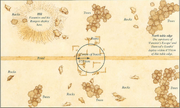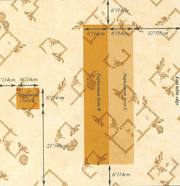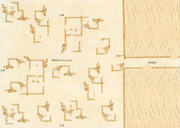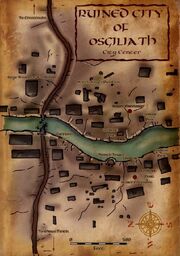
Map of Osgiliath
Osgiliath (S, pron. [osˈɡiljaθ]) was the old capital city of Gondor. The city straddled the Anduin River at a point approximately half way between the cities of Minas Anor to the southwest and Minas Ithil to the northeast, and north of the nearby Emyn Arnen.
In the Great Hall of the city the thrones of the sons of Elendil were set side by side. In its days of glory, the city featured quays to handle sea-going vessels that came up from the sea, a great stone bridge supporting houses and towers of stone, and the Dome of Stars, which housed the Osgiliath-stone, the greatest of the seven Palantíri.[
- Type: City in Decline (Third Age)
- Inhabitants: 90% Gondorian,10% Mixed Mannish .
- Population: TA 3019 ~2,500; (TA 1149 ~100,000)
- Origin: Founded by Elendil in SA 3320
- Purpose: The former capital of Gondor; a center for learning and art; the major port for Anduin traffic.
- Symbol: The White Tree surrounded by Seven Stars
History[]
Founded by Isildur and Anárion[1] near the end of the Second Age,[2] Osgiliath was designated the capital of the southern Númenórean kingdom in exile, Gondor. Soon after its founding, Sauron attacked and took Minas Ithil in S.A. 3429 and then moved westward. While Isildur sought aid from the north, Anárion defended the city. When the army of the Last Alliance arrived and later defeated Sauron the threat to the city was lifted.[1] Thereafter, for over a thousand years, Osgiliath was the capital of Gondor, as well as its largest and most important city.
The beginning of the city's decline came in T.A. 1437 when it was sacked and burned, after a siege by the rebel Castamir's forces during the Kin-strife. It was during this siege that the Osgiliath-stone was lost in the River. The Great Plague of T.A. 1636 led to further depopulation with many victims, and those who fled never returned. The city began to fall into ruin; the capital was moved to the more secure Minas Anor in T.A. 1640.
Over the next few hundred years, Gondor endured many military defeats east of the Anduin, especially the fall of Minas Ithil in T.A. 2002. Osgiliath became vulnerable to attack and was widely believed to be haunted, as its population continued to shrink. Osgiliath was finally abandoned by the remaining civilian population after being captured temporarily by Uruk-hai in T.A. 2475 until it was liberated by Steward Boromir.[3]
Over the following centuries, the western part of the ruined city was under the control of Gondor, and was at times provided with a military garrison as a means of defending the crossing of the Anduin. The eastern part, with Ithilien, was disputed territory, under Gondor's control for most of the rule of Denethor II, but in June of T.A. 3018 it was taken and occupied by Sauron's forces and its last bridge fell. This attack some later considered the beginning of the War of the Ring.[4]
In the following March, well into the War, Sauron launched a full-scale invasion of Gondor west of the Anduin, and despite the Rangers' defense of the western part of the city, Osgiliath quickly fell to Sauron's forces,[4] but it was reclaimed by Gondor after Sauron's ultimate defeat a few weeks later.
After the War, Osgiliath was apparently rebuilt[source?], but it never became as great as it once was. Minas Tirith remained the capital and King's city[source?].
Etymology[]
The Sindarin name Osgiliath, "Citadel of the Stars", consists of the elements ost ("fort, citadel") + giliath ("hosts of stars").
Places of Note[]

Battlefield outside the eastern gates of Osgiliath

Battlefield in central Osgiliath

Battlefield in eastern Osgiliath

Battlefield at the western end of Osgiliath's bridge

Battlefield on the Bridge of Osgiliath

Ruins in central osgiliath
- Abad Atanatar
- Abad Minalcar
- Ancient Harbor
- Armoury
- Arms Factory
- Bar Annabon
- Bar Raudh
- Basilica of Beruthiel
- Baths of Cerisan
- Bazaars
- Bull Market
- Burnt Column of Ostoher
- Captured Watchtower
- Cerisan Manor
- Common Hallows
- Condir Gate
- Crown Inn
- the Culverts
- Ranger Hideout
- Dome of Stars
- East Quarter
- Eastern Bridge
- Falasser Gate
- Falassion Gate
- Fisher-Town of Helluin
- Flooded Ruins of Belthil
- Foodmerchants
- Forum of Narmacil
- Forum of Turambar
- Gardens of Beleganor
- Gate of Salmar
- Gate of Tulkas Victorious
- Grain merchant's guild
- Great Granary
- The lower Harbor
- Great Bridge
- Healing Fountain
- High Archives
- House Calardan
- Houses of Healing
- Hyarmendol
- Hyarost Gate
- Iant Breithon
- Iant Ciryaher
- Ianr Rómendacil
- Iant Sollen
- The King's Library
- Lumbar Quays
- Mausoleum of Morvegil
- Men Alcarin
- Meneldil's Square
- Menelvagor Quays
- Military Baths
- Minas Númen
- Noble Houses
- northern bridge camp
- Obelisk of Atanatar
- Old Bridge
- Olive Trees
- Osgiliath Culverts
- Palace of Eldacar
- Palatium
- Romendacils square
- Rond Giliath
- Rotunda of Este
- Rotunda of Osse
- Rozinbarad
- Ruined Square
- Ruined Tower
- Ruins and Pasture
- Sactuary of Ulmo
- Serondo's Cellar
- Silver Gate
- sunken labyrinth
- Supply stores
- Theatre of Alagos
- Thoronúmen Ghetto
- Tol Gilthoniel
- the tunnels
- Warehouses and Brothels
- West Gate
- Westgate Gaol
- West Quarter
- Wilwarin Quarter
Characters:[]
Early Third Age[]
Men: Beruthiel
Animals: Ormenel
Before T.A.ca.1640[]
TA ca.3018-19:[]
Men: Boromir Candúr Damrod Daughter of Shadow Derufin Duilin Echil Faramir Golthor Halhir Jukotor Lord of Pinions Lúmithil Mablung Madril Meldir Norhún Thurindol Upâl-keng
Orcs: Aarlok Argdush Goroth Gothmog Grarbag Guriz Kamábhil Mornok Murgash Zagdûsh
Trolls: Gúrkodar Muzgásh Thrug
